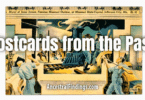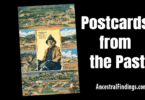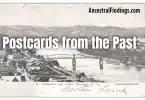Chimney Rock is one of those places that’s impossible to forget once you’ve seen it. Rising more than 200 feet into the air, that massive granite column looks like it’s reaching up to hold the sky. With an American flag at the top, it feels like a landmark that was always meant to be there—solid, steadfast, and full of meaning. Nature shaped it, but for us, it’s been a source of inspiration, a family destination, and even a Hollywood filming location.
The postcard I’ve got here captures Chimney Rock sometime around the middle of the last century. On the front, you see it rising proudly above the trees, flag waving in the mountain breeze. What makes the colors pop is that old linen-style printing that was popular in those days. Instead of a flat photograph, you get something almost painterly, with glowing colors that make the scene come alive. Flip it over, and the back is just as interesting—it calls the formation the “Mighty Chimney” and promises breathtaking views of the Blue Ridge Mountains, Hickory Nut Gorge, Lake Lure, and the Piedmont Plain. Even if you’d never set foot in North Carolina, just reading that little blurb would have stirred your imagination.
The story of Chimney Rock as a destination begins with a man named Dr. Lucius Morse. He was a physician who first discovered the area in the late 1800s. He fell in love with the rugged beauty of the mountains and knew it was something worth sharing. In 1902, with help from his brothers, he purchased the land. That was the beginning of Chimney Rock’s life as a public attraction. The Morse family got busy building stairways and trails to make the summit accessible, so anyone with a good pair of shoes and some determination could stand at the top. Later, they went even further, installing an elevator that made the climb manageable for families of all ages. At the time, that elevator was nothing short of remarkable. It opened the view not just to the young and athletic, but also to older visitors and little kids, allowing everyone to share in the experience together.
And it wasn’t just about the rock. In the 1920s, the Morses created another treasure: Lake Lure. They dammed the Broad River and gave the region a sparkling lake that soon became a hub for swimming, boating, fishing, and simple relaxation along its shores. When you pair Lake Lure with Chimney Rock, you’ve got the makings of a vacation paradise. It was no wonder families began traveling there in droves once the automobile made mountain getaways more practical.
Of course, traveling to Chimney Rock in those early years was an adventure all on its own. The roads were steep, narrow, and full of switchbacks. Most were unpaved, which meant you had dust in the dry season and mud in the wet. Cars back then didn’t exactly glide over the terrain. They chugged their way up those inclines, often overheating on the steeper stretches. Families would stop along the way at roadside stands where locals sold jars of honey, baskets of apples, or homemade jams. A cold soda from an icebox or a scoop of hand-cranked ice cream could make a hot summer drive feel like a treat. And there were those little motor courts and roadside cabins—simple but cozy—where you could rest for the night before tackling the final climb. For many travelers, the trip was as memorable as the destination. Reaching Chimney Rock felt like an achievement, the reward waiting at the end of a long, winding path.
That reward was the view. From the top, you could see for miles. The ridges of the Blue Ridge Mountains fading into the distance, the ribbon of Hickory Nut Gorge cutting its way through the rock, and Lake Lure gleaming in the sunlight. On a clear day, you could even catch sight of the flatlands of the Piedmont stretching away to the east. For families used to small towns and farm fields, this view was something unforgettable. It made you feel both small and mighty at the same time, like you were standing in a place where the whole world opened up in front of you.
I can tell you from personal experience, it’s something you never forget. I went there with my parents when I was young, and I remember the climb, the breeze, and that dizzying feeling of looking out across the mountains. Later, I brought my own kids, and seeing their excitement brought those old memories rushing back. It’s a place that ties generations together. The rock itself hasn’t changed, but each family that visits leaves with their own stories, their own little memories layered on top of everyone else’s.
And Chimney Rock isn’t just part of family vacations—it’s also been part of Hollywood. In 1992, it was featured in The Last of the Mohicans. Some of the most dramatic fight scenes in the movie were filmed on the cliffs and trails around the rock. If you’ve seen the film, you know how breathtaking those scenes are. And when you visit in person, you realize the movie didn’t exaggerate a thing. The landscape itself provided the drama. Even now, visitors walk along those same trails, half expecting to see the characters appear around a bend.
In 2007, Chimney Rock became part of North Carolina’s state park system. That move ensured the site would be preserved and protected, not just for today’s visitors, but for generations to come. And it worked—Chimney Rock still welcomes travelers from all over the world. They come for the hikes, for the views, and for the chance to stand on a piece of granite that has become so much more than just a rock.
That brings us back to postcards. In the 1940s and 50s, postcards weren’t just keepsakes. They were a way of sharing your journey with the people you left behind. Families collected them in albums, children traded them with friends, and travelers sent them home as proof of where they’d been. For the price of a penny stamp, you could mail a little slice of your adventure across the country. For some folks who couldn’t travel, postcards were their window into other worlds. And for those who did make the trip, the cards carried personal notes—sometimes just a quick “wish you were here,” but often a few details that told the story of the day.
That’s what makes a postcard like this one such a treasure. Even if it’s blank, it still tells us something about the era when it was printed—the pride people felt in these natural wonders, the way attractions were promoted, and what kinds of places travelers wanted to remember. And when you do find one with writing on the back, you’re holding more than a picture—you’re holding a memory in someone’s own words. Maybe it was your grandparents sending a note home after climbing the stairs to the top. Maybe it was tucked into an album after a long road trip through the Carolinas. Each one carries its own story.
Chimney Rock is more than stone. It’s a part of people’s lives—woven into road trips, movie history, and family traditions. It’s in the smiles of kids leaning over the railing to point out the lake below, in the quiet awe of parents watching the sunset together, and in the nostalgia of postcards that captured it all in bright colors.
And if you’ve got a postcard of your own—whether it shows a skyline, a main street, or something long gone—I’d love to see it. Just click on the Contact link at AncestralFindings.com and ask for my mailing address. There’s always room for more history on the shelf, and who knows? I may feature some of your postcards on a future podcast.






